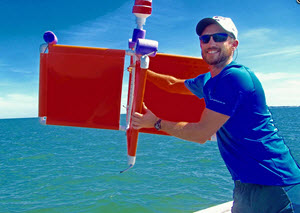
Steve releases a drifter at Main Pass (Mobile Bay), Alabama, to study the surface tidal plume. (Provided by Steve Dykstra)
When Deepwater Horizon oil approached coastal environments, it was unclear how river water entering the Gulf of Mexico would affect the oil’s transport and fate. Steve Dykstra uses drifters and ship-deployed sensors to study how freshwater plumes disperse in the coastal environment over different seafloor topography. He plans to someday use his findings and experience to help inform coastal resource management in developing countries.
Steve Dykstra is a Ph.D. student at the University of South Alabama’s marine science program and a GoMRI Scholar with the Consortium for Oil Spill Exposure Pathways in Coastal River-Dominated Ecosystems (CONCORDE).
His Path
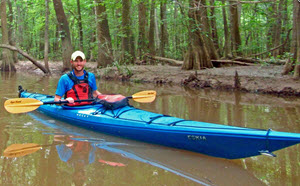
Steve explores the Mobile-Tensaw Delta to better understand how the area’s fluvial-tidal flow affects coastal circulation. (Provided by Steve Dykstra)
Steve became interested in science while exploring the forests, lakes, and wetlands around his childhood home near Lake Michigan. He was fascinated by nature’s complexity and developed a particular interest in river and stream morphology, which studies the form, function, and interactions of these waters with the surrounding landscape. As he grew up, Steve became more knowledgeable about morphology by frequenting sand dunes and learning how to redirect or “pirate” streams. He completed a bachelor’s degree in science at Calvin College in 2008 and decided his next steps would be less conventional.
Steve worked as a naturalist in Alaska’s Kenai Fjords National Park and Chugach National Forest, where he led tourist excursions and taught visitors about the area’s geology, ecology, and wildlife. Next, he volunteered for the NGO Help for the Massai, distributing food and helping run immunization clinics in Tanzania near Serengeti National Park in the Ngorongoro Conservation Area. “Working with the indigenous Massai people, I got a first-hand look at the developing world,” he said. “It taught me how to work cross-culturally.”
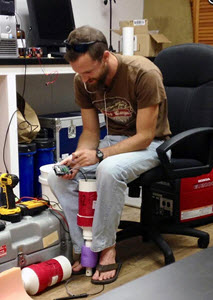
Steve prepares the microprocessors he constructed to go inside his drifters. (Provided by Steve Dykstra)
Steve completed an environmental science master’s degree at Taylor University and interned with Dynamic Solutions International’s watershed management program in Vietnam. He worked in watershed management in Tajikistan through the Global Partners organization. Security issues sent him back to the United States, and he decided to pursue a long-time desire – obtaining his Ph.D. Steve found an opportunity to research freshwater discharge’s influence on the coastal environment with Dr. Brian Dzwonkowski and joined his team at the Dauphin Island Sea Lab (DISL).
A personal motivator for Steve is a calling to Biblical stewardship. “As a Christian, I believe I’m called to care for and try to reconcile the world around me,” he said. “I think it’s something that a lot of Christians overlook, but stewardship includes the natural environment that we have.”
His Work
Steve works in the Mobile Bay delta, where tides influence river flow and level as it moves into the coastal area. As freshwater enters saltier waters, it remains on the surface and forms a plume that spreads over a wide area. However, changes in the coastal geomorphology can alter flow dynamics, salinity, and the freshwater’s movement into the Gulf. “Narrow or wide or deep inlets change the way water flows,” explained Steve. “As the geomorphology changes – either naturally or anthropogenically –it changes the flow dynamics, which inadvertently change how much salinity goes into the Bay and how the freshwater moves out into the Gulf.”
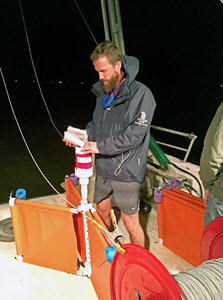
Steve prepares a drifter for release. (Provided by Steve Dykstra)
Steve’s component of the research focuses on Main Pass, Mobile Bay, where he helps build and release GPS-equipped drifters fitted with temperature and salinity sensors to study how fast they move, where they move, and how they spread out and disperse. He takes simultaneous measurements aboard a research vessel using conductivity, temperature, and depth (CTD) sensors and a Laser In-Situ Scattering and Transmissometry (LISST) instrument, which measures sediment grain sizes and concentrations in the water. He compares these measurements with the drifter readings to determine the plume’s movement relative to the surrounding environment, what it transports, and how it mixes with Gulf waters.
Steve’s observations will help validate a CONCORDE-developed circulation model reflecting the exposure pathways and mechanisms of Deepwater Horizon oil. His work will inform the land-to-sea portion of the model and compliment other researchers’ work in offshore regions. “It’s easier to predict how oil will function when it’s moving around in the Gulf of Mexico, but it’s more difficult to figure out how it will interact with the complex shoreline,” he said. “I’m taking observations to help inform and change the model to better reflect the system that we’re actually working with.”
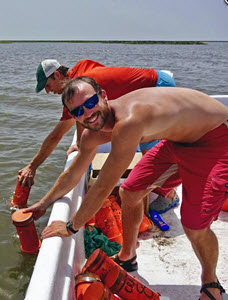
Steve and his advisor, Dr. Brian Dzwonkowski, release small drifters in the Grand Bay National Estuary Research Reserve. (Provided by Steve Dykstra)
His Learning
One of the greatest benefits from Steve’s GoMRI research has been the opportunity to take the time to delve into the materials and research. His past travels left him little opportunity to get to know a single system. “I often had to skip over some good insights and get more of the theory behind something instead of really learning one particular local environment. I think it’s been helpful to finally do and understand that,” he said. Steve’s GoMRI work also introduced him to marine science. Prior to beginning his Ph.D., Steve had never taken a marine science class and had little experience working in coastal or marine environments. He credits his research as the source of everything he currently knows about marine environments.
Steve also frequently works with his secondary advisor Kelly Dorgan, a sediment ecologist with the ACER consortium. Interacting with researchers from different projects helps him see differences in how consortia operate and coordinate when conducting research in same region. Steve meets and interacts with scientists in many disciplines and observes how they conduct their research and interact with other investigators. Steve reflected, “I’ve been able to learn quite a bit about discerning who to learn from and what questions to ask which researchers.”
His Future
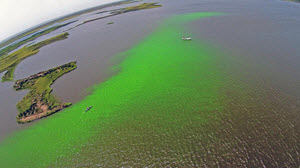
Steve and Dr. Dzwonkowski (white boat) follow drifters to compare their tracks with a dye release in Grand Bay National Estuary Research Reserve. (Photo by Robert Moorhead)
Steve is considering a post-doctoral position after graduation and becoming further established in his field. However, his long-term goal is to go back overseas and conduct research in resources management for developing countries, where he believes his education and experience in streams and coastal environments could help. “I’d like to help countries that are trying to manage their resources, particularly in deciding how to balance development and conservation. Whether I’m doing consulting work or conducting research with a local university, I’d like to continue to do some of the relief work I was doing previously but with further expertise.”
Steve advises that students considering a science career should start broad, learning a wide range of foundational material, and then specialize through research and internship opportunities. “Don’t do an internship because it looks good on your resume but chase your dreams and allow yourself to fail in that process,” he said. He hints that those opportunities might even offer a way to avoid debt after graduating, “Be willing to take things slower and work jobs that you may not have initially considered or move to places with better financial opportunities. I’ve been able to go through debt-free, not because I had parents assisting me, but because I worked hard and moved to places that I’d never been before.”
Praise for Steve
Dzwonkowski said that Steve has shown impressive ambition and an industrious nature throughout his graduate career. He said that Steve seeks ways to improve his grant-writing skills, hunting down external research funds to support his graduate career through student travel opportunities and prestigious fellowship opportunities. “Given his early and immediate interest in proposal writing, I am positive that Steve will be successful obtaining future research funds,” he said.
Dzwonkowski also highlighted Steve’s contributions to education and outreach efforts. DISL adapted Arduino computing components for their summer research, and Steve helped train students to wire and program the components and discussed how they could use the low-cost technology in their own research. He is preparing to help build Arduino-based technical skills into K-12 lesson plans. “He has a very positive influence on the people around him,” said Dzwonkowski. “He has been a great addition to DISL, and I look forward to seeing him develop along what I know will be a highly impactful career path. I believe he will make a difference in many peoples’ lives over the course of his career.”
The GoMRI community embraces bright and dedicated students like Steve Dykstra and their important contributions. The GoMRI Scholars Program recognizes graduate students whose work focuses on GoMRI-funded projects and builds community for the next generation of ocean science professionals. Visit the CONCORDE website to learn more about their work.
************
The Gulf of Mexico Research Initiative (GoMRI) is a 10-year independent research program established to study the effect, and the potential associated impact, of hydrocarbon releases on the environment and public health, as well as to develop improved spill mitigation, oil detection, characterization and remediation technologies. An independent and academic 20-member Research Board makes the funding and research direction decisions to ensure the intellectual quality, effectiveness and academic independence of the GoMRI research. All research data, findings and publications will be made publicly available. The program was established through a $500 million financial commitment from BP. For more information, visit http://gulfresearchinitiative.org/.
© Copyright 2010- 2017 Gulf of Mexico Research Initiative (GoMRI) – All Rights Reserved. Redistribution is encouraged with acknowledgement to the Gulf of Mexico Research Initiative (GoMRI). Please credit images and/or videos as done in each article. Questions? Contact web-content editor Nilde “Maggie” Dannreuther, Northern Gulf Institute, Mississippi State University (maggied@ngi.msstate.edu).
